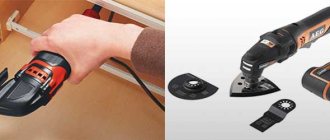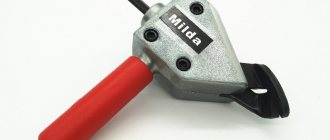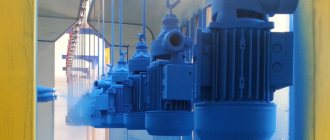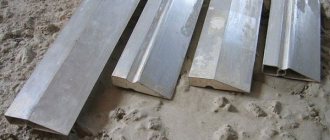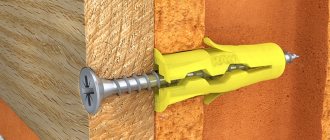Three types of tools are used to paint walls: brushes, rollers and spray guns. Which of these tools should you prefer if you are going to paint the walls in your apartment yourself? For this type of painting work, any specialist will recommend choosing a roller. Why?
The brush works on the surface slowly and often has to be dipped into paint. At the same time, achieving a uniform and even surface with its help is quite difficult. The spray gun copes well with the task of painting large areas and can create a perfectly even layer of paint. But it is quite expensive, and not everyone will decide to buy this unit for one-time work. The golden mean between simplicity and quality of work is the choice of roller. It can be called a unique tool because, having a simple design and low cost, it is incredibly effective.
Roller device
A roller for painting walls is a simple structure consisting of three parts:
- through cylinder made of wood, aluminum or plastic;
- absorbent coat;
- a handle consisting of a handle for holding the roller in the hand and a rod on which the cylinder is attached.
When an instrument is dipped in paint, the coat absorbs it over its entire surface. During operation, the cylinder rotates on a rod, ensuring uniform rolling of paint across the walls. Painting with a roller is a pleasure because it is almost effortless and does not require special skills. Thanks to the features of its device, this tool allows you to work quickly and save paint.
Lever
The length of the roller handle is usually from 30 to 50 cm. If it is necessary to lengthen the handle, for example, to paint the top of a high wall or ceiling, a special telescopic rod is used. It can be made of aluminum, plastic-coated metal, or fiberglass.
According to their design, handles are divided into two types:
- clasp;
- double-armed.
The clasp handle is, in fact, a curved metal rod on which an attachment is attached - a cylinder with a fur coat. A special coupling or pin is used to secure the nozzle.
USEFUL INFORMATION: Polypropylene hot water pipes are an excellent alternative to metal pipes.
The double-arm handle is a fork that holds the nozzle on both sides.
Attaching the nozzle
Depending on the method of attaching the nozzle, the rollers are:
- detachable;
- hard.
The detachable roller allows the use of replaceable attachments. This is very convenient, because under one handle you can select attachments with different coats and change them as needed.
The rigid roller is a one-piece structure. After the coat wears out, such a tool will have to be thrown away entirely, since the handle and the nozzle are inseparable from each other.
Fur coat materials
Foam rubber
A foam roller can be purchased cheaper than any of its analogues. It has a dense elastic structure, which is ideal for priming: the tool can hold the liquid composition and distribute it evenly over the surface “perfectly.” Foam rubber also works well with wallpaper glue, as well as with water-dispersed and acrylic compounds. But solvents and synthetic resins are contraindicated for it - the fur coat material may peel off
.
In general, a foam roller is not the best solution for painting walls and ceilings. It is not convenient and not at all practical, and the result can be very disappointing: the applied layer often contains air bubbles, disrupting the uniformity of the coating. There is also no shortage of splashes and drips during the work process. But for priming there is no better option. Pros of foam rollers:
- good compatibility with primer compositions;
- ability to quickly restore shape;
- affordable price.
Minuses:
- susceptibility to chemical paints and solvents;
- high probability of applying an uneven coating (in the case of paints), a large number of smudges.
Microfiber/polyester
Another inexpensive representative of paint rollers for painting.
The material perfectly absorbs the coloring composition and retains it during the work process, allowing the most uniform layer to be applied. You don’t have to worry about splashes and falling fluff. This roller combines well with acrylic and dispersion paints, ideal for treating smooth walls indoors, as well as for repainting. To apply white and light-colored compounds, experts also recommend buying a microfiber paint roller. Advantages of microfiber rollers:
- good absorbency;
- does not leave lint;
- affordable price.
Minuses:
- low wear resistance;
- short service life.
Polyacrylic
Artificial material with very dense pile.
Excellent for painting walls and ceilings, allows you to work without splashes or smudges. Gives even coverage. You can buy an acrylic roller for both interior and exterior decoration - such a tool is practical and very easy to use. However, it is worth considering that the material can only be combined with water-based compounds. Pros of acrylic rollers:
- neat work;
- uniform coverage;
- fast and high-quality results.
Minuses:
- the choice of coloring compositions is very limited;
- high price.
Polyamide/nylon
Very wear and chemical resistant synthetic material.
It has a fairly wide range of pile lengths - from 8 to 20 mm, thanks to which the nylon roller can safely be called universal. With the help of such a tool, you can quickly and effectively process both a perfectly smooth wall prepared for painting and an uneven surface with an impressive amount of roughness - the main thing is to choose the right model. This roller is best combined with water-dispersion-based compositions. Pros of nylon rollers:
- versatility of use;
- wide selection of models;
- resistance to chemicals.
Minuses:
- the pile is prone to shedding;
- Working with budget models is often accompanied by splashes.
Flock
One of the best roller materials for finishing.
The roller itself is smooth and is used exclusively on smooth surfaces that are ideally prepared for painting. Essentially, these are polyurethane fibers on a textile basis - a “fiery” combination that gives the instrument’s coat resistance to moisture and excellent strength characteristics. Advantages of flock rollers:
- strength;
- durability;
- affordable price.
Minuses:
- the tool is not effective for processing uneven and rough surfaces;
- impracticality, the material is electrified, attracting dust and debris.
Velours
Soft, pleasant to the touch “plush” material is also good for finishing.
It goes well with a wide variety of compositions, from water-dispersion to alkyd and oil paints. However, experienced painters warn: painting walls and, especially, ceilings with a velor roller is time-consuming, difficult and burdensome. The fine, very dense pile of the instrument absorbs the composition extremely poorly, which is why the process is drawn out over time, and the result can be very disappointing. But it is best suited for varnishing smooth wooden surfaces or parquet. Advantages of velor rollers:
- combines with a wide variety of formulations;
- resistant to solvents;
- Great for rolling out varnish.
Minuses:
- a large amount of splashes during work and low efficiency;
- high consumption of coloring material.
Fur
The roller can be made of either natural or artificial fur.
The first variation is most often made from sheep wool (less often from llama wool) and works well when working with water-dispersion and oil paints, varnishes, and enamels. At the same time, lime for natural fur is prohibited. The artificial analogue is considered more universal and practical. In general, it is fur products that are able to give the highest quality results, ideally coping with “problem” surfaces, and also have good absorbency and allow you to consume less paint. Advantages of fur rollers:
- high quality painting;
- minimum splashes during work;
- significant savings in paint and varnish composition.
Minuses:
- during the painting process, the fibers “fall off”, and quite abundantly;
- relatively high cost.
Note:
You can also buy a reinforced roller in modern stores, in which the pile is secured with a strong thread - nylon or fiberglass. Thanks to this technology, the process of painting walls/ceilings becomes of the highest quality, and the tool itself can last much longer than its analogues.
Classification by size
Rollers can be divided into three groups depending on the width and diameter of the nozzle:
- Mini rollers. They have a small width of the working part - up to 150 mm. Designed for painting small surfaces or hard-to-reach places, such as corners.
- Midi or medium size rollers. The width of the nozzle of such a tool is from 150 to 200 mm, the diameter can be from 40 to 70 mm. This type is the most common and versatile, since it represents the optimal combination of good coverage area and low weight.
- Facade rollers have the largest size, their width exceeds 250 mm, the diameter of the nozzle is more than 80 mm. Large rollers are a professional tool; they have a thickened shaft and a high-quality coat. A facade painting tool soaked in paint has a decent weight, so it requires a certain skill.
Content:
What could be easier than painting a wall with a roller? I dipped it in the paint, shook it off a little and began to move it along the wall. Of course, if you follow this scheme, then there is nothing surprising in stains, splashes and the presence of unpainted areas.
What does a quality result depend on? Of course, the list of reasons includes both the skill of the master and the quality of the paint itself. One of the most important conditions for an evenly painted surface is the correct choice of roller for the job. Here is a clear example: after painting the ceiling, small bubbles formed on its surface, which over time began to peel off. Why? The reason is the foam roller, which is not recommended for such work. Next, we will look at what types of rollers and for what surfaces are best used.
How to choose the length of the pile
The length of the roller pile determines the amount of paint it can absorb and, accordingly, the thickness of the applied paint layer. Long pile has thicker threads, short pile has thinner threads. The choice of pile length depends on the texture of the walls being painted.
- For a rough surface - putty, concrete, wood - a fur coat with a pile of medium length - 5-20 mm - is best suited.
USEFUL INFORMATION: How to choose wallpaper for the living room: interior design
- For smooth walls made of metal, plastic or plasterboard, you will need a fur coat with a pile length of up to 5 mm;
- Large-relief surfaces, for example, those covered with textured plaster, are painted with a tool with a pile length exceeding 20 mm.
What can be used additionally
For structural finishing of surfaces, not only paint rollers are used, but also:
- wide hard brushes; with their help you can glaze the base coat, giving the wall a rich texture;
- special brushes made of elastic material, allowing you to make the surface look like a cut of natural wood;
- stencils are widely used for applying designs and ornaments.
You can leave beautiful prints on the wall using a crumpled sheet of paper or plastic film, a piece of fabric or a soft skein of thread of different textures.
Textured rollers
Relief and structural rollers can be distinguished into a separate category. These tools are designed for additional decoration of the surface to be painted. The attachment of such a roller can be made of rubber, leather, foam rubber, wood, and has a protruding pattern applied to it. When rolled evenly over fresh paint, it leaves imprints on it.
Using a relief tool, you can apply a design or pattern to painted walls using paint in a contrasting color. Texture rollers are also used to create a certain texture on decorative plaster, paint, and liquid wallpaper.
Which roller to paint the ceiling with: the optimal choice of quality, type, material
The ceiling is the first thing that attracts the eye when entering a room. Therefore, all the owners try to make it impeccable and perfect. The craving for idealism and the inexperience of home craftsmen are the reasons for a considerable share of the questions that arise during the repair of this particular demanding surface. One of them - which roller to paint the ceiling with - is worthy of detailed consideration, since there is no definite answer to it. A hasty decision does not at all guarantee high-quality coverage, because all types of these tools are designed for “their” jobs. An important role is played by the width of the roller, the length of the handle, the height and characteristics of the coat, and the characteristics of the surface to be painted.
How to choose a quality roller
Construction stores offer a huge variety of rollers from different manufacturers, and it is often difficult for a novice craftsman to understand which tool is of better quality. In order to make the right choice, you need to remember several features that a good tool should have:
- When squeezing the fur attachment, it should quickly restore its original shape.
- The coat of the roller should look neat, individual threads or hairs should not come out of it, and the seams should not stand out.
- Pay attention to the stripes on the fur coat. Longitudinal stripes indicate that the fur coat is sewn and can be replaced if necessary. Such coats are made for high quality instruments. Transverse and oblique stripes mean that the fur coat is glued and cannot be replaced.
- The number of stripes indicates resistance to aggressive components of paints and varnishes. The more there are, the higher the stability of the roller.
Key points in painting the ceiling
The first stage of painting work begins with the purchase of paint. It is best to choose water-based dyes for painting ceilings. They are practically odorless, dry quickly, are easy to apply, immediately improving the appearance of the ceiling surface. The instructions on the can will help you make the right choice of paint, where you will also find information about the method of diluting the composition. As a rule, ordinary water is used as a solvent, which is added to the jar in an amount of approximately 10% of the total volume.
But most often the emulsion is already sold ready-made, and it can be immediately used for coloring.
Advice! To make painting easier, add a small amount of paint to the paint tray. Then splashes will not form, and the paint in the required amount will be collected on the roller.
Water-based paints are made on acrylic, silicate, silicone or mineral bases. For example, an acrylic coating is not completely washed off with water, since it contains glue and latex, which ensures reliable adhesion to the surface being painted.
Water-based paint dries much faster than oil paint. And this is an absolute plus. For the bathroom or kitchen, choose silicone-based compounds that tolerate temperature fluctuations well and are resistant to mechanical stress.
A detailed report on what paint to use for the ceiling, the best manufacturers and compositions.


